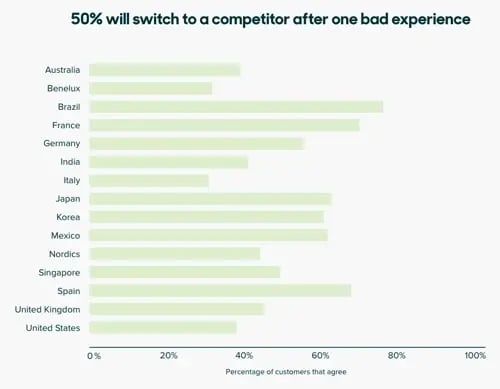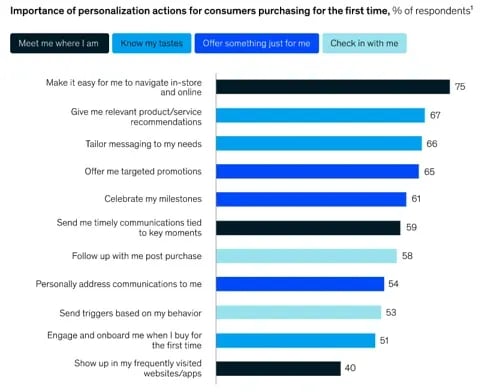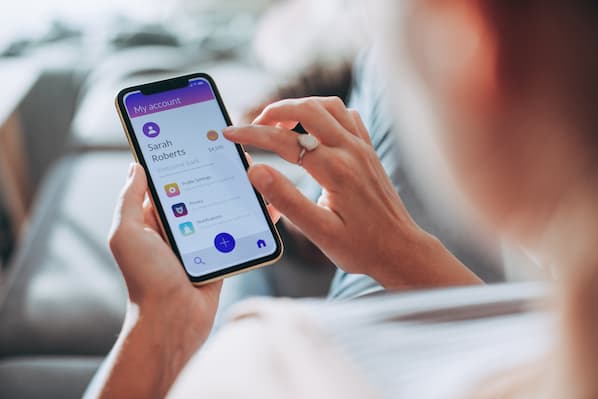According to a 2021 McKinsey report, 76% of consumers get frustrated when they can’t find a personalized experience with a brand.
With personalization becoming more valuable to stand out from the competition, a look at some great examples can serve as inspiration for your own strategy.
Download Now: Free State of Marketing Report
[Updated for 2025]
Discover brands that are killing it at personalization and get a peek into how impactful it can be.
Why do we prefer personalized experiences?
Twilio’s 2022 State of Personalization report found that 49% of consumers say they will likely become repeat buyers after a personalized shopping experience with a retail brand.
Businesses also report that consumers spend more when they have a personalized experience. In fact, 80% of business leaders surveyed in Twilio’s report say that consumers spend an average of 34% more with a personalized experience.
Conversely, all it takes is one bad experience to deter a customer. One 2021 Zendesk CX report found that 50% of consumers will switch to a competitor following a negative brand interaction.

So, the question is, why is that? What is it about this type of experience that attracts consumers and why is it so fragile? One study may have the answer.
According to a study from the University of Texas, we can attribute our preference for personalized experiences to two key factors: desire for control and information overload. Let’s tackle "desire for control" first.
So, we know that a personalized experience – by its very nature – is in some way different from the status quo. You’re not just getting what everyone else is getting with personalization. Instead, you’re getting something tailored to you. And because of that, it makes you feel more in control.
Even if this sense of control is an illusion, it’s still powerful, and can have a positive effect on your psyche.
Now, let’s turn to the second factor mentioned in the University of Texas study: information overload. According to the study, personalization can help reduce this perception.
For example, when you know that the content being displayed on a website is tailored to you, it provides a more manageable framework for engagement. With personalization, you aren’t presented with thousands of resources to sort through and consume.
Instead, you are presented with exactly the information you were looking for. Hence, you never feel overloaded with information.
Now that you know the psychology behind personalized experiences and how effective they can be, let’s dive into some real-world examples.
Personalized Marketing Experiences
Personalization covers a wide range of strategies leveraged by brands both online and offline. Some brands take an omnichannel approach while others focus their efforts on specific channels.
To get a sense of what’s possible, here are a few examples of personalization:
- Names in email subject lines and email content.
- Location-based push notifications.
- Welcome back messages on a website homepage.
- Cart abandonment notifications.
- CTAs based on buying cycle.
- Product recommendations based on purchase and/or search history.
- Customer loyalty programs.
According to the same McKinsey & Company report referenced earlier, the top five personalization actions consumers want are: easier online and in-store navigation, personalized product or service recs, tailored messages, relevant promotions, and personal milestone celebrations.

Let’s see those strategies applied by brands.
1. Sephora
When it comes to personalization, Sephora is one brand everyone looks to.
Over the years, the beauty retailer continues to optimize its omnichannel personalization strategy, ranking consistently among the top winners in Sailthru’s Retail Personalization Index for the past five years.
At the center of Sephora’s personalization is its mobile app. One of the first things you notice about the app is its ability to turn customer data (collected through quizzes and user behavior) into recommendations using predictive analytics.
The app houses data on in-store purchases, browsing history, purchases, and in-store interactions.
Where the brand really shines is in its ability to combine online and in-store to create a seamless, frictionless experience for shoppers.
The app invites users to find products in-store and book in-person consultations. Once in-store, customers will receive a log-in for the app to create a profile that includes the products they used. This way, they can always find the information they need for a future purchase.
In addition, Sephora has a loyalty program in which it offers exclusive access to products, events, and services based on their tier. At every touchpoint, users can track their loyalty points and get custom recommendations.
2. Netflix
Everyone’s Netflix account looks different when you log in.
That’s because the streaming service has made it a priority to personalize the user experience as they navigate the platform.
The first display of this is the large banner ad that displays when you first land on the app. It’s usually a trailer for a newly added show or movie – the difference is the selection is different for everyone.
For me, that might be the newly released season of Peaky Blinders since I’ve seen all previous seasons. For another, it might be something else.
As you scroll through the app, you’ll see two more personalized sections: "Because you watched" and "Picked for you."


Through AI and machine learning, Netflix’s algorithm is programmed to suggest shows and movies based on a user’s watching history, including watch time and review.
What you end up with is a programming list with elements from content you’ve enjoyed in the past, making it easier to pick something new. Plus, it keeps you coming back for more.
That’s the beauty of the app – you know that everything is curated just for you based on your personal interests.
3. Amazon
If you currently oversee an ecommerce store, Amazon is a great model to get inspiration from.
This retailer has created an interface that offers relevant recommendations based on browsing and purchasing history.
When you first land on the homepage, you’ll have the option to navigate to the following sections:
- Keep shopping for
- Pick up where you left off
- Buy it again
- You might also like
- Inspired by your wish list
- Recommended for you
Every single one of these sections is personalized to the user based on their behavior on the site.
In addition to inferring information about its customers, Amazon will occasionally survey its users.
For instance, shortly after purchasing a product for my cat, the following question popped up on my homepage: "Do you own a dog or cat?" They explained that this information would be used to offer more personalized recommendations.
A key takeaway here is to fill in gaps in your data by reaching out to your users. This will be especially important if you're using AI-powered software and need to feed it information to guide its algorithm.
Personalized experiences are the way of the now and the future. The earlier you jump on, the easier it will be to keep up with consumer behavior.
Editor's Note: This post was originally published in Nov. 2014 and has been updated for comprehensiveness.



![How to Create a Complete Marketing Strategy [Data + Expert Tips]](https://www.hubspot.com/hubfs/marketing-strategy.webp)



![Top Marketing Channels in 2025 — Here’s What Your Team Needs to Master [Data]](https://www.hubspot.com/hubfs/marketing%20channel.png)


![What's a Marketing Audit? [+ How To Do One]](https://www.hubspot.com/hubfs/Marketing%20Audit.png)
![2025 CPL and CAC Benchmarks [HubSpot Research]](https://www.hubspot.com/hubfs/cost-per-lead-benchmark-1-20250227-9826989.webp)
